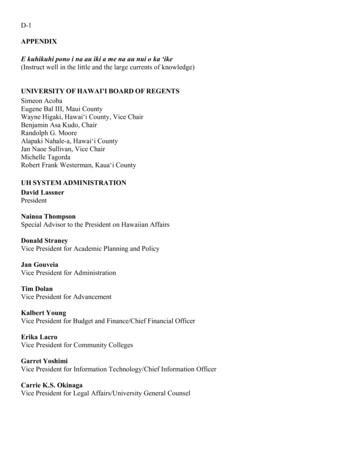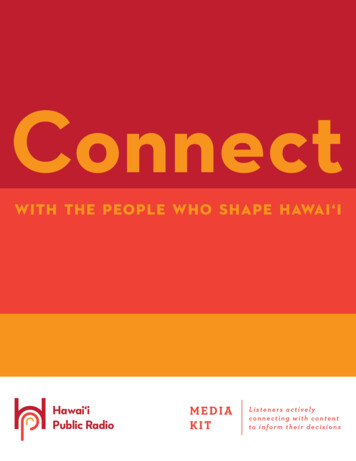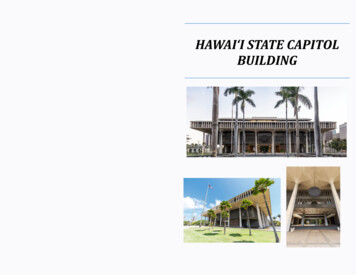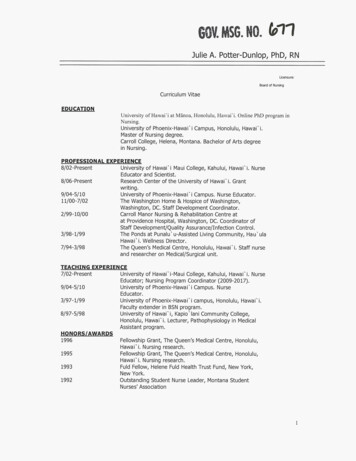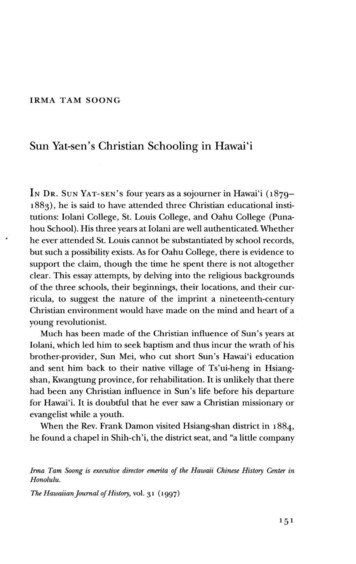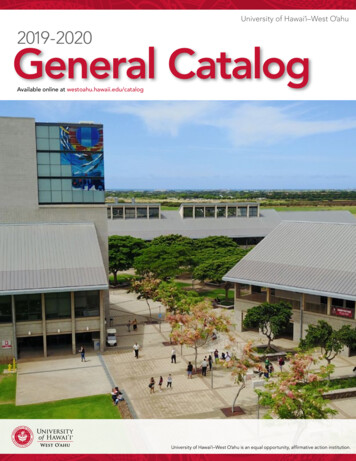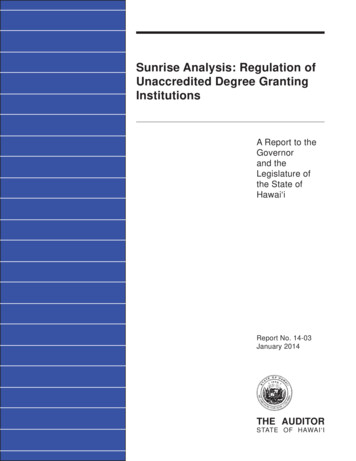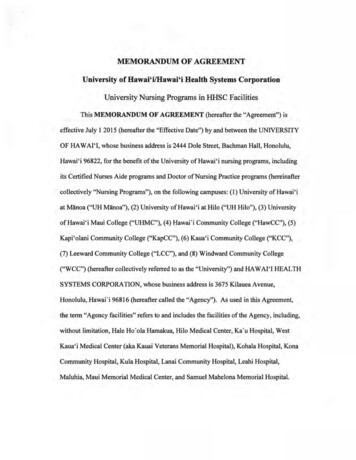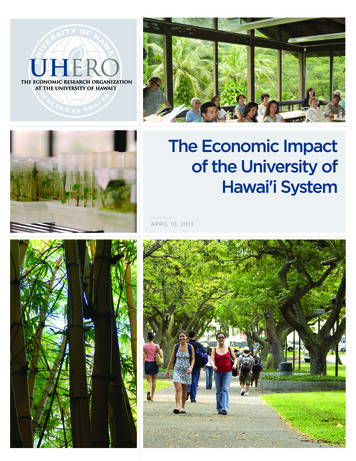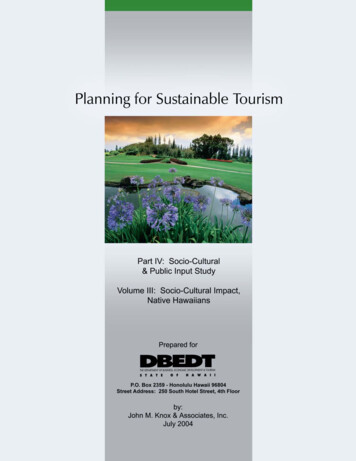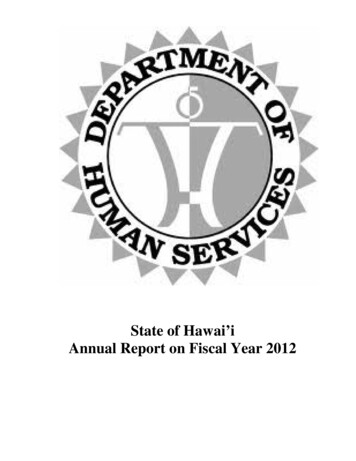
Transcription
State of Hawai’iAnnual Report on Fiscal Year 2012
Director’s Message for DHS 2012 Annual ReportThe Department of Human Services (DHS) serves vulnerable and needy adults and children across the State.DHS employees work hard to provide timely, efficient and effective programs, benefits and services thatempower clients to achieve self-sufficiency, self-determination, independence, healthy lifestyles, and personaldignity. This report provides an in-depth explanation of how DHS is meeting its Department objectives whilealso streamlining government services along the lines of the Governor’s New Day Initiative.DHS is the State’s second-largest department and manages an annual budget of 2.2 billion. The Departmentoperates four divisions: Social Services Division (SSD), Benefit, Employment & Support Services (BESSD),Med-QUEST (MQD) and Vocational Rehabilitation & Services for the Blind (VRSBD). Together, thesedivisions: Help clients escape poverty and achieve full employment; Prevent abuse and neglect among children and vulnerable adults; Strengthen families and promote positive youth development; Provide high-quality public health insurance to low-income adults and children; and Empower people with disabilities so the can enter or re-enter the workforce.Following work force reductions and hiring freezes implemented by the previous administration, the DHS issuccessfully restoring personnel capacity and government functions. BESSD provided supplemental nutritionbenefits (SNAP) to 176,676 people in FY 2012, and successfully implemented a same-day-service businessprocessing model in 95% of public assistance offices. BESSD is exceeding federal compliance rate forhouseholds enrolled in the First-to-Work Program, and more than 14,380 individuals received assistance from theBESSD Homeless Programs Office and its contracted agencies. The BESSD Child Care Connection Programassisted 20,234 families, and the Investigations Unit recovered 3,387,946 in restitution. The VRSBD served5,903 individuals with disabilities, and celebrated eight employers that hired people with disabilities. VRSBDalso changed its name to the Division of Vocational Rehabilitation (DVR). MQD oversaw health care benefits formore than 287,000 eligible residents, while simultaneously preparing to implement provisions of the AffordableCare Act. The SSD continues to keep recurring child abuse and/or neglect rates below the average nationaltolerance standard, and to care for Hawai’i’s vulnerable elderly population. The DHS attached agencies continueto support Hawai’i’s vulnerable populations. The Office of Youth Services continues funding more than 90community based contracts to address the statewide needs of at-risk youth and their families, and the HawaiiPublic Housing Authority, the Hawaii State Commission on the Status of Women, and the Commission onFatherhood are expanding their community outreach.Many thanks to all DHS staff who remain committed to the Department and to Hawai’i’s most vulnerable people.Mahalo,Patricia McManaman, DHS Director
TABLE OF CONTENTSORGANIZATION CHART6CHAPTER ONE: INTRODUCTION7CHAPTER TWO: SELF-SUFFICIENCY8A. Benefit, Employment& Support Services Division (BESSD)Programs, Services, Achievements, and Looking Ahead1) Temporary Assistance for Needy Families (TANF) and Temporary Assistance forOther Needy Families (TAONF)82) General Assistance (GA)123) Aid to the Aged, Blind, and Disabled (AABD)164) First-To-Work Program (FTW)185) Employment and Training (E&T)216) Child Care Program Office227) Hawai’i Head Start Collaboration Office248) Supplemental Nutrition Assistance Program (SNAP)259) Homeless Program Office2710) Investigations Office29B. Vocational Rehabilitation and Services for the Blind Division (VRSBD)Programs, Services, Achievements, and Looking Ahead1) Vocational Rehabilitation Program312) Ho'opono Services for the Blind Program323) Disability Determination Program33CHAPTER THREE: PROTECTIONSocial Services Division (SSD)Programs, Services, Achievements, and Looking Ahead1) Adult Protective Services (APS)in the Adult and Community Care Services Branch (ACCSB)3535Senior Volunteer Programs38Senior Community Service Employment Programs40Licensing and Certification Programs40Other Adult Services422) Child Welfare Services (CWS)43Abuse and Neglect45Foster Care48
CHAPTER FOUR: HEALTH61A. Med-QUEST Division (MQD)Programs, Services, Achievements, and Looking Ahead61Application and Eligibility611) Hawai’i QUEST Managed Care (QUEST)632) Hawai’i QUEST Expanded Access (QExA)633) Medicaid Fee-For-Service (FSS)644) Early and Periodic Screening, Diagnosis, and Treatment (EPSDT)645) QUEST-NET646) QUEST Spenddown657) QUEST-ACE (Adult Coverage Expansion)658) Transitional Medical Insurance659) State Children’s Health Insurance Program (S-CHIP)6610) Immigrant Children and Pregnant Women6611) Breast and Cervical Cancer Program6612) Funeral Payments Program6613) Third Party Liability Program6714) Medicare Modernization Act – Medicare Part D6715) Medicaid Waiver Program6716) Going Home Plus68Health Insurance Portability and Accountability Act (HIPAA)68CHAPTER FIVE: ADMINISTRATIONA. Support ServicesCHAPTER SIX: ATTACHED AGENCIES6970A. OFFICE OF YOUTH SERVICES (OYS)Programs, Services, Achievements, and Looking Ahead701) Positive Youth Development (PYD)702) Youth Gang Prevention and Intervention703) Truancy Prevention and In-School Suspension704) Community-based Outreach and Advocacy705) Intensive Monitoring Program706) Day Treatment Center717) Community-based Residential Services718) Hawai’i Youth Correctional Facility (HYCF)719) Federal Grant Programs7110) US DOE, Title IV, Part A, Safe and Drug Free Schools and Community Act7211) US Department of Health and Human Services, Title XX Block Grant73
B. HAWAI’I PUBLIC HOUSING AUTHORITY (HPHA)75C. HAWAI’I STATE COMMISSION ON THE STATUS OF WOMEN75D. HAWAI’I COMMISSION ON FATHERHOOD77APPENDIXI. BUDGET FOR FISCAL YEAR 201278II. ELIGIBILITY AND BENEFIT CRITERION79
The administrative offices of the Department of Human Services are located in the Queen LiliuokalaniBuilding, 1390 Miller Street in downtown HonoluluCHAPTER ONE: INTRODUCTIONThe Territorial Department of Public Welfare was reorganized as the State Department of Social Services and Housing(DSSH) in 1959 after statehood by the State Legislature. In 1988, the Department was again reorganized and redesignated as the Department of Human Services (DHS). Currently, the DHS has about 1,800 permanent positions and anannual budget of over 2.2 billion dollars.The DHS staff is committed to providing timely, efficient, and effective programs, services, and benefits to empowerthose who are the most vulnerable in our State, and to expand their capacity for self-sufficiency, self-determination,independence, healthy choices, quality of life, and personal dignity. The DHS has four divisions that provide differentkinds of assistance: The Benefit, Employment and Support Services Division (BESSD) provides financial assistance, supplementalnutrition, employment support, dependency diversion and prevention services, and child care licensing. BESSDalso supports emergency shelters and transitional shelters for homeless Hawai’i residents; The Med-QUEST Division (MQD) provides health insurance to low-income families, children and individuals; The Social Services Division (SSD) provides protective services for abused adults and children, and offers familystrengthening, child abuse and neglect prevention services, and licensing some long-term care home andcommunity-based providers; and The Vocational Rehabilitation and Services for the Blind Division helps persons with disabilities and the blindbecome employed, start their own businesses and live independently. This Division has been renamed theVocational Rehabilitation Division (DVR).The DHS also has two administratively attached agencies and commissions. The Office of Youth Services (OYS)maintains the State’s only youth correctional facility and provides community-based services to Hawai i’s at-risk youth toprevent delinquency. The Hawai’i Public Housing Authority (HPHA) manages and maintains housing and emergencyshelter and transitional shelters opportunities with resident support services.The DHS also supports two State commissions. The Hawai’i State Commission on the Status of Women (HSCSW) wasestablished to aid implementation of recommendations impacting women and girls, to develop long-range goals and tocoordinate research planning, programming and action on the opportunities, needs, problems and contributions of womenand girls in Hawai’i. The Hawai’i Commission on Fatherhood (HCF) was established by Act 156, SLH 2003, and directsthe Commission to serve in an advisory capacity to State agencies to promote healthy family relationships betweenparents and children.The four divisions of the DHS, along with its four administratively attached agencies and commissions are assisted by fivestaff support offices. Staff provides administrative hearings for clients, fiscal management, information technologysystems support, management services, research, personnel and other services. The DHS maintains statewide offices in88 separate locations.7
CHAPTER TWO: SELF-SUFFICIENCYA. BENEFIT, EMPLOYMENT AND SUPPORT SERVICES DIVISIONPrograms, Services, Achievements, and Looking AheadThe BESSD staff provides basic support to needy families including, financial assistance and supplemental nutritionassistance program (SNAP) benefits. The BESSD also provides an array of job-readiness trainings, educational andvocational trainings, job placement and retention services, child care, transportation and work related expenses to assistclients in achieving self-sufficiency.1) Temporary Assistance for Needy Families (TANF) and Temporary Assistance for Other Needy Families(TAONF)Program DescriptionTANF and TAONF provide limited monthly cash benefits to eligible families for food, clothing, shelter, and otheressentials. To qualify for either subsidy, a family must include dependent children under the age of 19 and thefamily’s total gross income must be under 185% of the 2006 Federal Poverty Level (FPL). For a household of threepersons, this means the monthly gross income must be less than 2,941. The net income must be under 48% of the2006 FPL or less than 610 if the household includes an employable adult. All TANF/TAONF households arepermitted to acquire resources or assets, but the combined total must be less than 5,000. Vehicles, and the home inwhich a household resides, are not included as assets or resources.Family participation in TANF or TAONF depends on the household composition. Effective October 2008, familiesare eligible for federally-funded welfare under TANF if all family members are U. S. citizens. Families that includeat least one non-U.S. citizen are eligible for state-funded cash assistance under TAONF. Non-citizens are permanentresident aliens residing in the U.S. for more than five years, certain vulnerable legal immigrants residing for less thanfive years in the U.S., or individuals from the Compact of Free Association (COFA) nations of Micronesia, Palau andthe Marshal Islands. Other than these different funding sources, the TANF/TAONF programs are identical.TANF and TAONF are time-limited financial assistance programs for work eligible needy adults with dependentchildren. The programs are designed to promote self-reliance, responsibility and family stability. They require ablebodied adults to engage in work activities and to provide services to individuals who are unable to work. Both theTANF and TAONF programs offer employment incentives, child care and transportation support for working parents,and reimbursement for pre-approved work related expenses such as tools, uniforms, and union dues. Children who donot reside with their parents may also receive assistance when residing with a non-needy caretaker relative.Financial assistance for needy families was increased in July 2007 for the first time since 1994. Payment standardsrose from 62.5 % of the 1993 FPL to 50% of the 2006 FPL. Effective July 1, 2009, the payment standards werereduced to 48% of the 2006 FPL as a cost saving measure for the State. These reduced amounts were still more thanthe 1994 payment amounts.The Department continues to provide dependency prevention and poverty prevention programs and services. Since 2004, the Department has provided Positive Youth Development and Family Strengthening programs toimprove the lives of needy children, teens and their parents. They include the Department of Education’sUPLINK program, and statewide programs offered by youth centers and private agencies such as PACT,Goodwill Industries, the Salvation Army, Susannah Wesley, Child and Family Service, Kokua Kalihi Valley,YWCA of Kauai, Hale Kipa, and Catholic Charities. These programs engage youth in positive activities anddiscourage risky behaviors leading to truancy, pregnancy, substance abuse and crime. The programs providepositive information that promotes healthy choices and outcomes. National studies confirm that positive youthdevelopment programs reduce teen pregnancy, school drop-outs, substance abuse and other risky behaviorsleading to dependence on government aid. The Up-front Universal Engagement (UFUE) program began as a grant diversion program in 2005 to divertfamilies away from public assistance. It was revised in 2008 to a pay-after-performance TANF assistanceprogram. Adults who are able to work, or those who have barriers to employment, must participate in and complywith work related or assessment activities before the family can receive regular TANF or TAONF assistance8
payments. Following full implementation of the pay-after-performance system in State FY 2011, 55% of Hawai’ihouseholds were diverted away from the TANF program and into the job market.Program GoalFamilies will achieve financial self-sufficiency.ObjectiveMeasurementsThe economic well-being of the client willimprove.1. Average earnings per case will increase.2. The proportion of individuals working willincrease.3. Total income will increase.4. Hours worked will increase.Family stability will improve.The percentage of intact (two-parent) householdswill increase.Recidivism will decrease.Fewer cases will return to welfare once off thesystem.Financial assistance program savings willincrease.Costs will decrease for the financial assistanceprogram.TANF/TAONF Program AchievementsHawai’i’s welfare reform program is innovative, progressive and realistic. It provides the appropriate combinationof incentives to work and disincentives to remain dependent on public assistance. For example: The cost of assistance per TANF household has decreased from a high of 650 per month in 1997 to 504 permonth in FY 2012;The average length of time on assistance decreased from 30 months in 1997 to 15.2 months in FY 2010.Based on the number of cases closed in FY 2012, the average length of assistance was 13.5 months;With the implementation of our December 1996 welfare reform waiver, the number of families receivingassistance decreased from 22,785 cases to 10,014 cases in June 2011; however, the caseload increased to10,300 in June 2012; andIn July 2011, 2,345 households were employed and earning a gross income of 2.37 million per month,representing a monthly cost savings to the State of 762,431. In June 2012, 2,522 households were employedand grossing 2.5 million, representing a cost savings of 804,731 to the State.9
TANF/TAONF CaseloadAverage # Familiesper MonthFiscal 01410,300Average Timeon 16.513.5*Average time on assistance was re-computed from the start of TANF/TAONF on July 1997.TANF/TAONF (By Selected Months)Sept 1997Number ofHouseholdsAssistedMonthlyBenefits Paid toHouseholdsNumber ofEmployedHouseholdsGross EarnedIncomeReportedJuly 2007July 2009July 2010July 2011July 201223,5738,3818,6619,44810,01410,312 12.92 million 4.6 million 3.46 million 5.29 million 5.63 million 5.55millionUnavailable1,3652.0602,2242,3452,522 3.7million 1.5 million 1.8million 1.9million 2.4million 2.5millionBESSD continues to expand training and skill-building programs for clients with a temporary disability or othersignificant barrier to self-sufficiency.We have contracted services for victims of domestic violence (DV), substance abuse, and individuals with physical ormental disabilities. Work requirements for DV victims may be suspended for up to six months to permit programparticipation with a possible extension of six months. Assessments are conducted on an individual basis to keep theparents focused on working or returning to work, as soon as it is safe to do so.10
Compliance with substance abuse rehabilitation programs, medical treatment, and skill-building programs areconditions of eligibility for those who need these services. The focus is on helping families achieve self-sufficiencythrough the contracting of case management services for recovery activities, employment and skill development.These programs and services are intended to improve the self-sufficiency skills of all BESSD families and accordingto federal public assistance laws, enable them to comply with work participation requirements according to federalpublic assistance laws. To maintain eligibility, all adults are required to participate in some work related activity,whether it is training, counseling, treatment or work. Through contracts with the Legal Aid Society of Hawai’i (LASH), the Supplemental Security Income (SSI)advocacy program continues to assist disabled individuals receiving federal TANF assistance or state-fundedTAONF assistance to qualify and receive SSI federal benefits. SSI benefits are higher than our State benefits, andare not time-limited. BESSD continues to implement dependency diversion and poverty prevention programs and services with thegoal of preventing people from needing public assistance. The medical review process for disabled TANF/TAONF recipients is performed by contracted physicians andpsychiatrists. The process standardizes the determination of disability to emphasize ability to work. It alsofocuses on treatment compliance to ameliorate disabilities, and enable recipients to work. A medical reviewboard reviews all medical findings to more consistently plan for appropriate support services. With physician,psychologist and psychiatrist disability determinations, vocational rehabilitation contractors can better servicerecipients and assess the level and types of activities the TANF/TAONF recipient may perform. A total of 3,409exams were performed in FY 2012. BESSD continues to align its Financial Assistance program policies with those of the Supplemental NutritionalAssistance Program, with the goal of providing consistent eligibility criteria for BESSD programs. To establish and determine TANF/TAONF eligibility, program applicants are required to perform countable Firstto-Work (FTW) activities, which include attending assigned meetings. Called the pay-after-performancerequirement, BESSD has shortened the process for applicant families from a maximum of 21 days to 7 days.There are exceptions for families with children under the age of six months, those without an adult in thehousehold, and those with one adult caring for a disabled household member.Recent Program Improvements The Business Process Re-engineering Project (BRPR), which converts the case management process to a taskoriented process, has been implemented statewide. Conversions to the new service delivery model wereconducted in stages, beginning with Maui and East Hawai’i in November 2011. The final conversion at the WestHawai’i offices occurred in October 2012. BESSD continues to monitor and evaluate this new process to ensurethat it serve our clients in a timely manner. BESSD continues to recommend that all potentially eligible TANF/TAONF applicants/recipients apply for SocialSecurity Disability (SSD) or Supplemental Security Income (SSI) benefits.People Served by TANF/TAONF ProgramsWhile each family that receives financial assistance is unique, we can identify some common characteristics. Forexample, the average case size (family size) was three people for FY 2012. Other characteristics include: Householdsthat include an adult without work barriers are allowed to receive TANF or TAONF cash benefits for a lifetimemaximum of five years (60 months). In FY 2003, 1,251 cases were closed due to time limits; in FY 2012, 367 caseswere closed due to time limits. The Department continues to expand its outreach activities to ensure that familiesapproaching the 5-year limit are prepared with a self-sufficiency plan.11
Job preparation, job search skills, training and educational services are available. Transitional benefits are provided tothose who are employed. We also have expanded supportive services for individuals with barriers to employment.Our intent is to assist and guide families towards self-sufficiency as expeditiously as possible.Composition of TANF/TAONF Households, FY 20121,4392,592Child OnlyOne ParentYear# Closed TANF CasesTwo Hawai’ian/Part Hawai’ian2009415Other Pacific 6Ethnicity of Individuals Served by TANF/TAONF ) General AssistanceProgram DescriptionThe General Assistance (GA) program provides cash benefits for food, clothing, shelter, and other essentials to adultsages 18 through 64, without minor dependents, who are temporarily disabled and who do not qualify for SocialSecurity, or who are waiting for the approval of SSI or Social Security Disability benefits. To be eligible for GA, theadult must have little or no income, not qualify for a federal category of assistance, and be certified by a DHS medicalboard as being unable to engage in any substantial employment of at least 30 hours per week for a period of at least 60days. To maintain eligibility, assets may not exceed 2,000 for a single person and 3,000 for a couple.The GA program is an annual block-grant, appropriated by the State Legislature. The DHS adjusts the monthlybenefit amount throughout the year based on the number of individuals participating in the program. The eligibilitystandard was increased due to budget constraints in July 2007 for the first time since 1994. Separately, it wasnecessary to reduce the benefit to 234 between April and June 2009. The Department increased the per monthpayment amount to 353 in July 2011 when a new appropriation was made available. Effective October 2011, basedon budget projections for FY 2011, the payment was reduced to 319 a month.12
Program GoalTo provide temporary economic assistance to those eligible for financial support and to ensure they receive at least aminimally adequate standard of living.MeasurementsObjectiveEligibility based on disability will bestandardized.The DHS will refer all applicants to a medicalprovider; and 100% of disability statements willbe reviewed by a Departmental medical board.Supplemental Security Income (SSI)referrals and approvals will increase.Based on reviews and recommendations ofDepartmental medical board, clients will bereferred to LASH and for SSI advocacy.GA Program Achievements16,428 medical evaluations were completed in FY 2012. 24% were determined not-disabled, 58.5% were determinedpsychiatrically-disabled, and 17.5% were determined physically-disabled. In FY 2012, the medical review boardreversed 7.2% of determinations compared to 7.3% reversals in FY 2011. The DHS continues to require that all individuals who claim a disability be examined by a contracted medicalprovider. All medical examinations are then reviewed by a contracted medical board. This process has beenstandardized to determine if a person is disabled and eligible for the GA program. DHS continues to contract for Social Security advocacy services to maximize the number of recipients eligible forfederal assistance. The total number of referrals approved for SSI/SSDI decreased from 36% in FY 2011 to 34%in FY 2012. Of those totals, 86% of approvals were for GA applicants or recipients.The two above procedures enable the transfer of persons with long-term disabilities to the federally-funded SSI andSSD programs. The financial assistance application form has been revised to include an authorization that allows BESSD to makeSSI referrals to its contracted social security advocate, Legal Aid Society of Hawai’i (LASH). Previously,recipients had to provide signed authorization for referrals. Through this process, the overall number of referralshas increased. A disability re-determination is obtained from the DHS examiner when requested. An alert is system-generatedbased on the date specified by the examiner. When the new determination is obtained, the eligibility workerevaluates whether the disability continues, or is expected to continue, at least another year. If it will continue, areferral will be made to SSI through LASH. The medical review board also recommends referrals to SocialSecurity. Memorandums of Understanding (MOU) with the Department of Public Safety and the Hawai’i State Hospitalwere developed and continue to be implemented. This allows DHS to process in advance, people with seriousmental illness who are being released from these facilities. The MOUs allow these individuals to receivecontinuous uninterrupted support and services. Instructions to refer recipients to the Aid to Disabled Review Committee (ADRC) have been reissued for adetermination of permanent disability. A determination of permanent disability by the ADRC allows the transferof a GA recipient to the Aged, Blind and Disabled (AABD) program.13
Performance Targets Monitor the Social Security advocacy contract to provide an effective advocacy program. The Social Securityadvocacy contract with LASH was extended to maximize the number of people eligible for federal assistance.This service has been made available to families and single adults in our TANF, TAONF, GA, and AABDprograms. As a result of this contract, 539 individuals were converted from State assistance to federal SocialSecurity in FY 2011. 39% of the referrals were approved. The Interim Assistance Reimbursement authorization is being automated to facilitate reimbursement to theDepartment when a recipient is determined eligible for SSI.Combined Reimbursement of State Funds for AABD, GA and TAONF from the SSAFiscal Year2009201020112012Reimbursementfrom the SSACost of LASH Contracts forReimbursement Activities 1,021,894 1,050,416 834,539 632,074Reimbursement toState (Net) 490,175* 678,200 640,875 471,437 997,890 372,216 193,664 160,637*LASH reimbursement is done on a per case basis. The LASH contract cost is higher for theseparadoxical reasons: (1) the time needed for approvals of initial applications is a very short 3 -5months. This means applicants receive benefit payments from the State for a shorter time andtherefore, there is a smaller amount to be reimbursed from each applicant; (2) at the same time, morehearings are lasting longer than a year. This means that reimbursements for these cases are delayedbeyond the current fiscal year. Monitor the medical evaluation contract to ensure the definition of disability is more focused on ability to work.This includes compliance to treatment and assurance. The contracted physicians and psychiatrists coordinate witha vocational rehabilitation contractor or a substance abuse counselor to determine the amount and type of activitythe GA applicant or recipient may perform. Effective October 1, 2011, medical evaluators once again beganmonitoring compliance to treatment for recipients with a diagnosis of substance abuse. Previously, substanceabuse and vocational rehabilitation contractors did the monitoring, but a change was necessary to reduce statefunded expenditures.Individuals Served by GA Program Per 5001420102011
Citizenship of Individuals Served by GA ProgramUnited States Citizens92%Non-citizens8%GA CaseloadYear2000Individuals per 20115,29820125,537Ethnicity of Individuals Served by GA ProgramEthnicityCaucasianHawai’ian/Part Hawai’ianChineseFilipinoJapaneseBlackOther AsianSamoanKoreanOther Pacific IslandersOthersPercentage FY40%29%1%9%5%3%2%3%1%6%1%Characteristics of Individuals Served by GA ProgramIndividual CharacteristicsPercentage*Age of Head of Household29 Years or Younger19%Between 30 and 39 Years19%Between 40 and 49 Years28%Between 50 and 59 Years28%60 Years and Older5%Marital Status of Head of HouseholdSingle62%Gender of Head of HouseholdMale62%Female38%Length of Time on Welfare8.6 months*These percentages remained consistent over the past four years, varying only one or two percentagepoints.15
3) Assistance to the Aged, Blind, And DisabledProgram DescriptionThe Assistance to the Aged, Blind and Disabled (AABD) program provides cash benefits for food, clothing, shelter,and other essentials to elderly adults (65 years of age or older) or to those who meet the Social SecurityAdministration (SSA) definition of disabled or blind. Most of these individuals are not eligible for federal SocialSecurity benefits. To qualify, individuals must have countable income below 34% of the 2006 Federal Poverty Leveland resources not exceeding 2,000 for a single person or 3,000 for a couple.Program GoalProvide economic assistance to those eligible for financial support to ensure they receive at least a minimallyadequate standard of living.ObjectiveMeasurementTo guarantee that everyone who desiresassistance and who meets the eligibilityrequir
6) Day Treatment Center 71 7) Community-based Residential Services 71 8) Hawai'i Youth Correctional Facility (HYCF) 71 9) Federal Grant Programs 71 10) US DOE, Title IV, Part A, Safe and Drug Free Schools and Community Act 72 11) US Department of Health and Human Services, Title XX Block Grant 73
